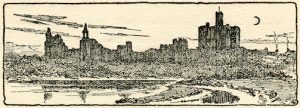THE NORTHUMBRIAN SMALL PIPES SOCIETY was founded in 1893 by members of the Society of Antiquaries of Newcastle upon Tyne, and existed until 1900. During its existence the NSPS maintained a tradition of piping competitions that had been initiated in the 1870s, promoted lectures and, perhaps most significantly, in 1896 published J W Fenwick’s Instructions for the Northumbrian Small Pipes.
The Society also published their Transactions for the years 1894 and 1896-7, and an account of their Annual Meeting of 1897. These reveal much about the activities and attitudes of the gentlemen of the Society, and confirm their interest in studying the pipes’ history and culture as well as in the actual playing. The membership of the NSPS was categorised into Members, who paid a minimum subscription of 5s (five shillings, or 25 new pence), and Honorary Playing Members. A number of the subscribers were also members of other antiquarian or cultural societies and subscribed to various publications relating to local history and culture; it is possible that they saw Northumberland piping chiefly as an element in the emerging cultural and historical identity that was becoming defined as ‘Northumbrian’.
The membership lists in the Transactions offer a useful insight into the actual players of the time, although this is necessarily a ‘snapshot’ which does not take account of the players’ various origins and movements, and, of course may not be comprehensive. A total of 37 Honorary Playing Members are listed between 1894 and 1897, which probably represents a fairly accurate account of mature players at the time. There were only 35 players at any one time.
The addresses of all the members of both categories, are also listed, which helps to positively identify them as individuals. The players lived within an area extending from a southern boundary in mid-Durham (Willington, Darlington and Bishop Auckland) to Haltwhistle in the west of Northumberland, thence north-east to the North Tyne Valley and Kielder Water (Bellingham, Wark and Falstone) and on to north Northumberland (Alnwick), then south again to Morpeth, south east Northumberland and Tyneside. Broadly, this area describes the county of Northumberland and the eastern part of County Durham.
Seventeen – nearly half – of the playing members listed came from the industrial and mining areas of Tyneside and south-east Northumberland, with three of those living in the North Shields area and six in the mining towns and villages between the rivers Tyne and Wansbeck. In effect, these nine players, a quarter of the known players of Northumberland small pipes, came from the North Shields and south-east Northumberland areas.
The President of the Northumberland Small Pipes Society was Richard Welford, the historian, and the Vice-President was Richard Oliver Heslop, the author of “Northumbrian Words”, a 2-volume glossary published for the English Dialect Society. The administration of the NSPS lay in the hands of a large committee of 26, only one of whom, J W Fenwick, was an Honorary Playing Member.
The committee included a number of men who lived in North Shields, most of whom were related. The unrelated member was Horatio Adamson of Tynemouth. The Honorary Secretary was Walter S Corder, who lived in Rosella Place. His second cousin James Watson also lived in Rosella Place, and C J Spence, cousin to Watson, lived at South Preston Lodge which lay adjacent to Rosella Place (approximately where St Cuthbert’s RC Church stands today). Four other members of this extended family were also members of the NSPS. Charles James Spence designed both medals and graphics for the NSPS, such as this page header showing Warkworth castle:
C. J. Spence was an active piper, and owned the six-drone set of pipes which was photographed for the frontispiece of the Fenwick instruction book. This appears to have been the six-drone set commissioned from James Reid by Cornelius Stanton of Tynemouth – no other contemporary six-drone set is known. He also knew Richard Mowat, who played at a series of “Conversazioni” that Spence organised in Tynemouth, and Robert Duggan of Shiremoor, a Highland and Northumberland piper and pipemaker, who may have taken on some sort of pipes maintenance role after James Reid died.
Robert Spence Watson, Liberal statesman, Privy Councillor, highly respected industrial arbitrator and a keen folklorist, was cousin to both James Watson and C. J. Spence and also a member of the NSPS. In 1878 he had donated the Spence Watson Trophy for the earlier series of piping competitions, which was won outright in 1880 by ‘old’ Tom Clough. His daughter Mary played pipes all her life, having been taught by Richard Mowat of Backworth, and in adult life she maintained an intermittent correspondence with ‘young’ Tom Clough until the 1950s. This correspondence led to the Spence Watson Trophy being returned to the family by Tom Clough, and subsequently donated to the Society of Antiquaries Bagpipe Museum in the Black Gate at Newcastle. It is now on display in the Morpeth Chantry Bagpipe Museum.
In summary, key members of the Northumbrian Small Pipes Society were from North Shields, and were from a family directly involved with piping from the 1870s at the latest. Earlier generations of that family had both personal and commercial relationships with Thomas and Robert Bewick. Both Bewicks had strong links to Tynemouth, and Robert Bewick was a well-known piper.

